roof PEUGEOT 3008 2016 Owners Manual
[x] Cancel search | Manufacturer: PEUGEOT, Model Year: 2016, Model line: 3008, Model: PEUGEOT 3008 2016Pages: 344, PDF Size: 12.23 MB
Page 4 of 344
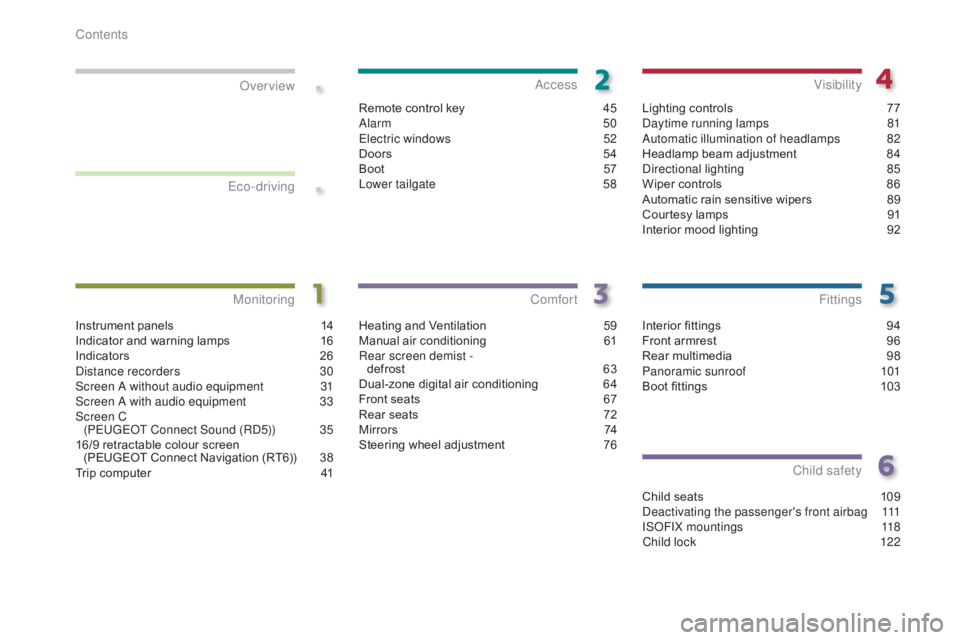
.
.
3008_en_Chap00a_sommaire_ed01-2015
Interior fittings 94
Front armrest 9 6
Rear multimedia
9
8
Panoramic sunroof
1
01
Boot fittings
1
03
Fittings
Child seats 109
Deactivating the passenger's front airbag 1 11
ISOFIX mountings
1
18
Child lock
1
22
Child safety
Instrument panels 1 4
Indicator and warning lamps 1 6
Indicators
2
6
Distance recorders
3
0
Screen A without audio equipment
3
1
Screen A with audio equipment
3
3
Screen C (PEUGEOT Connect Sound (RD5))
3
5
16/9 retractable colour screen (PEUGEOT Connect Navigation (RT6))
3
8
Trip computer
4
1
MonitoringOver view
Heating and Ventilation 5
9
Manual air conditioning 6 1
Rear screen demist - defrost
6
3
Dual-zone digital air conditioning
6
4
Front seats
6
7
Rear seats
7
2
M i r r o r s
74
S
teering wheel adjustment
7
6
Comfort
Remote control key 45
Alarm 5 0
Electric windows
5
2
Doors
5
4
Boot
5
7
Lower tailgate
5
8
Access
Lighting controls 77
Daytime running lamps 8 1
Automatic illumination of headlamps
8
2
Headlamp beam adjustment
8
4
Directional lighting
8
5
Wiper controls
8
6
Automatic rain sensitive wipers
8
9
Courtesy lamps
9
1
Interior mood lighting
9
2
Visibility
Eco-driving
Contents
Page 5 of 344
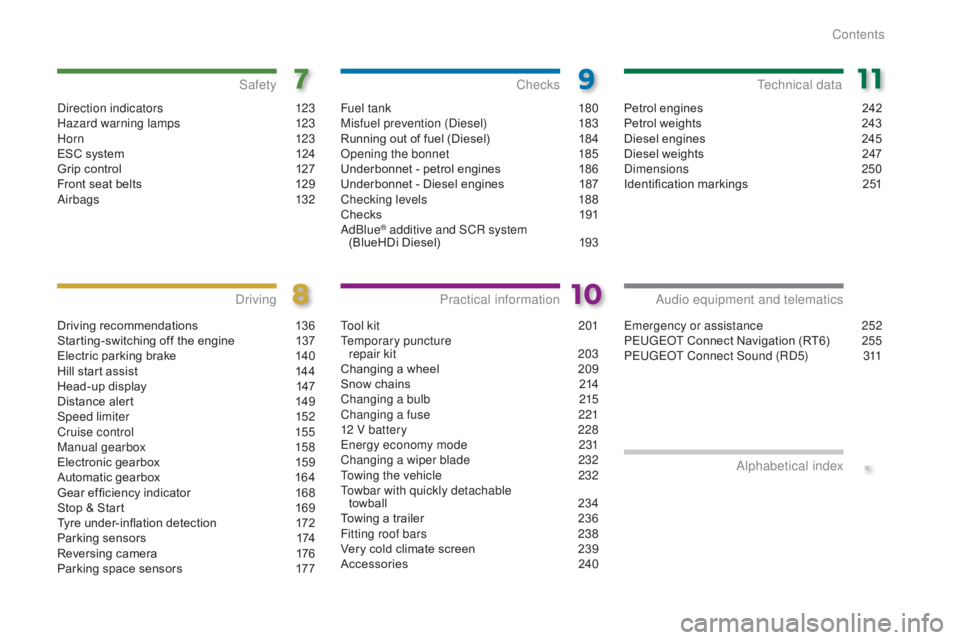
.
3008_en_Chap00a_sommaire_ed01-2015
Direction indicators 123
Hazard warning lamps 1 23
H or n
12
3
ESC system
1
24
Grip control
1
27
Front seat belts
1
29
Airbags
1
32
Safety
Driving recommendations 136
Starting-switching off the engine 1 37
Electric parking brake
1
40
Hill start assist
1
44
Head-up display
1
47
Distance alert
1
49
Speed limiter
1
52
Cruise control
1
55
Manual gearbox
1
58
Electronic gearbox
1
59
Automatic gearbox
1
64
Gear ef ficiency indicator
1
68
Stop & Start
1
69
Tyre under-inflation detection
1
72
Parking sensors
1
74
Reversing camera
1
76
Parking space sensors
1
77
Driving
Emergency or assistance 2 52
PE UGEOT C onnect Navigation (RT6) 2 55
P
E
UGEOT
C
onnect Sound (RD5)
3
11
Audio equipment and telematics
Alphabetical index
Fuel tank 1 80
Misfuel prevention (Diesel) 1 83
Running out of fuel (Diesel)
1
84
Opening the bonnet
1
85
Underbonnet - petrol engines
1
86
Underbonnet - Diesel engines
1
87
Checking levels
1
88
Checks
19
1
AdBlue
® additive and SCR system
(BlueHDi Diesel) 1 93
Checks
Tool kit 2 01
Temporary puncture repair kit
2
03
Changing a wheel
2
09
Snow chains
2
14
Changing a bulb
2
15
Changing a fuse
2
21
12 V battery
2
28
Energy economy mode
23
1
Changing a wiper blade
2
32
Towing the vehicle
2
32
Towbar with quickly detachable
towball
2
34
Towing a trailer
2
36
Fitting roof bars
2
38
Very cold climate screen
2
39
Accessories
2
40
Practical information
Petrol engines 2 42
Petrol weights 2 43
Diesel engines
2
45
Diesel weights
2
47
Dimensions
250
Identification markings
2
51
Technical data
Contents
Page 6 of 344
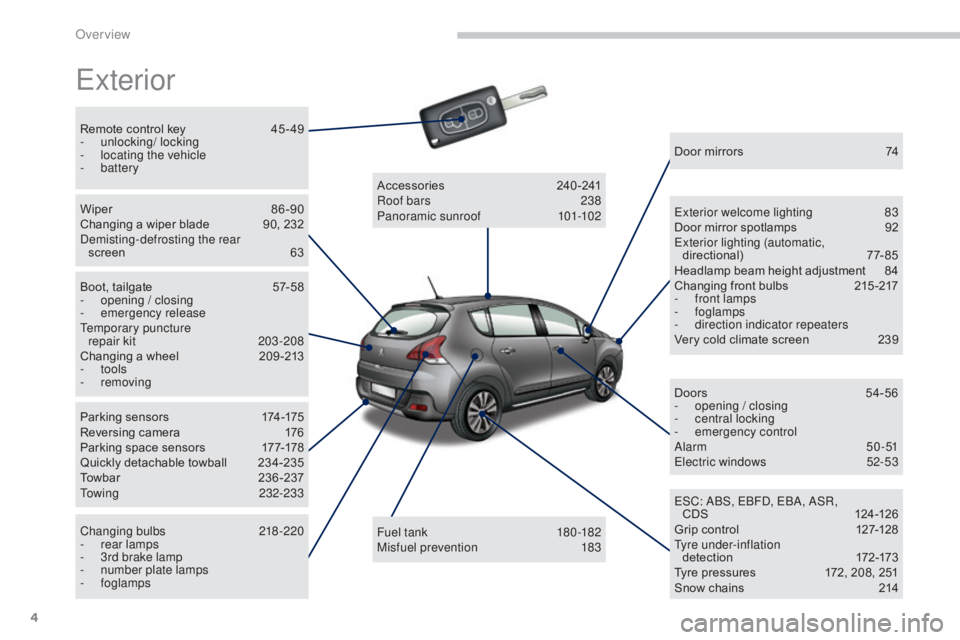
4
3008_en_Chap00b_vue-ensemble_ed01-2015
Exterior
Remote control key 45 - 49
- u nlocking/ locking
-
l
ocating the vehicle
-
battery
Wiper
8
6 -90
Changing a wiper blade
9
0, 232
Demisting-defrosting the rear screen
6
3
Boot, tailgate
5
7-58
-
ope
ning / closing
-
em
ergency release
Temporary puncture repair kit
2
03-208
Changing a wheel
2
09 -213
-
tools
-
removing
Parking sensors
1
74-175
Reversing camera
1
76
Parking space sensors
1
77-178
Quickly detachable towball
2
34-235
Towbar
23
6-237
Towing
232-233
Changing bulbs
2
18-220
-
r
ear lamps
-
3
rd brake lamp
-
n
umber plate lamps
-
foglamps Fuel tank
18
0 -182
Misfuel prevention
1
83
Accessories
2
40-241
Roof bars
2
38
Panoramic sunroof
1
01-102Door mirrors
7
4
Exterior welcome lighting
8
3
Door mirror spotlamps
9
2
Exterior lighting (automatic, directional)
7
7-85
Headlamp beam height adjustment
8
4
Changing front bulbs
2
15 -217
-
f
ront lamps
-
foglamps
-
d
irection indicator repeaters
Very cold climate screen
2
39
Doors
5
4-56
-
ope
ning / closing
-
c
entral locking
-
em
ergency control
Alarm
50-51
Electric windows
5
2-53
ESC: ABS, EBFD, EBA, ASR, CDS
12
4 -126
Grip control
1
27-128
Tyre under-inflation d ete c t i o n
17
2-173
Tyre pressures
1
72, 208, 251
Snow chains
2
14
Over view
Page 9 of 344
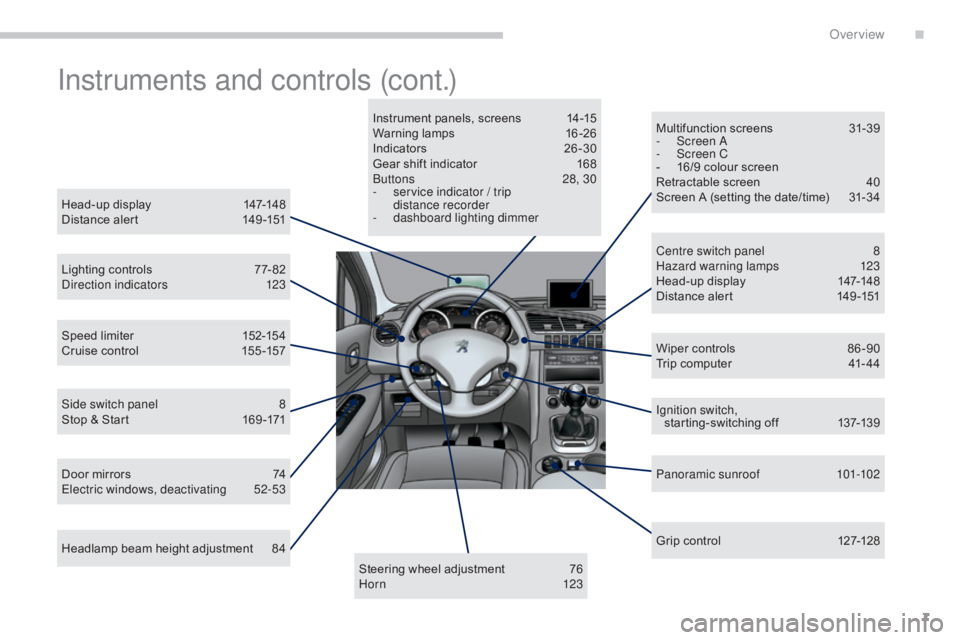
7
3008_en_Chap00b_vue-ensemble_ed01-2015
Instruments and controls (cont.)
Head-up display 147-148
Distance alert 1 49 -151
Lighting controls
7
7- 82
Direction indicators
1
23
Speed limiter
1
52-154
Cruise control
1
55 -157
Door mirrors
7
4
Electric windows, deactivating
5
2-53
Side switch panel
8
S
top & Start
1
69 -171
Headlamp beam height adjustment
8
4 Multifunction screens
3
1-39
-
S
creen A
-
S
creen C
-
1
6/9 colour screen
Retractable screen
4
0
Screen A (setting the date/time) 3 1-34
Wiper controls
8
6 -90
Trip computer
4
1- 44
Centre switch panel
8
H
azard warning lamps
1
23
Head-up display
1
47-148
Distance alert
1
49 -151
Ignition switch, starting-switching off
1
37-139
Panoramic sunroof
1
01-102
Grip control
1
27-128
Steering wheel adjustment
7
6
H or n
123
Instrument panels, screens
1
4-15
Warning lamps
1
6-26
Indicators
2
6-30
Gear shift indicator
1
68
Buttons
2
8, 30
- s ervice indicator / trip
distance recorder
- d
ashboard lighting dimmer
.
Over view
Page 14 of 344
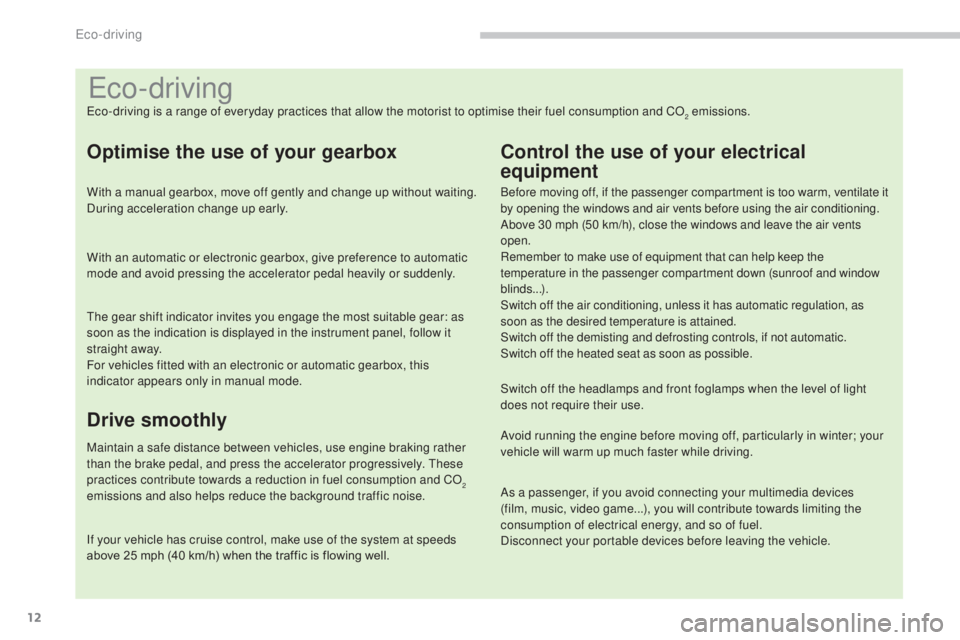
12
3008_en_Chap00c_eco-conduite_ed01-2015
Eco-driving
Eco-driving is a range of everyday practices that allow the motorist to optimise their fuel consumption and CO2 emissions.
Optimise the use of your gearbox
With a manual gearbox, move off gently and change up without waiting.
During acceleration change up early.
With an automatic or electronic gearbox, give preference to automatic
mode and avoid pressing the accelerator pedal heavily or suddenly.
The gear shift indicator invites you engage the most suitable gear: as
soon as the indication is displayed in the instrument panel, follow it
straight away.
For vehicles fitted with an electronic or automatic gearbox, this
indicator appears only in manual mode.
Drive smoothly
Maintain a safe distance between vehicles, use engine braking rather
than the brake pedal, and press the accelerator progressively. These
practices contribute towards a reduction in fuel consumption and CO
2
emissions and also helps reduce the background traffic noise.
If your vehicle has cruise control, make use of the system at speeds
above 25 mph (40 km/h) when the traffic is flowing well.
Control the use of your electrical
equipment
Before moving off, if the passenger compartment is too warm, ventilate it
by opening the windows and air vents before using the air conditioning.
Above 30 mph (50 km/h), close the windows and leave the air vents
open.
Remember to make use of equipment that can help keep the
temperature in the passenger compartment down (sunroof and window
blinds...).
Switch off the air conditioning, unless it has automatic regulation, as
soon as the desired temperature is attained.
Switch off the demisting and defrosting controls, if not automatic.
Switch off the heated seat as soon as possible.
Switch off the headlamps and front foglamps when the level of light
does not require their use.
Avoid running the engine before moving off, particularly in winter; your
vehicle will warm up much faster while driving.
As a passenger, if you avoid connecting your multimedia devices
(film, music, video game...), you will contribute towards limiting the
consumption of electrical energy, and so of fuel.
Disconnect your portable devices before leaving the vehicle.
Eco-driving
Page 15 of 344
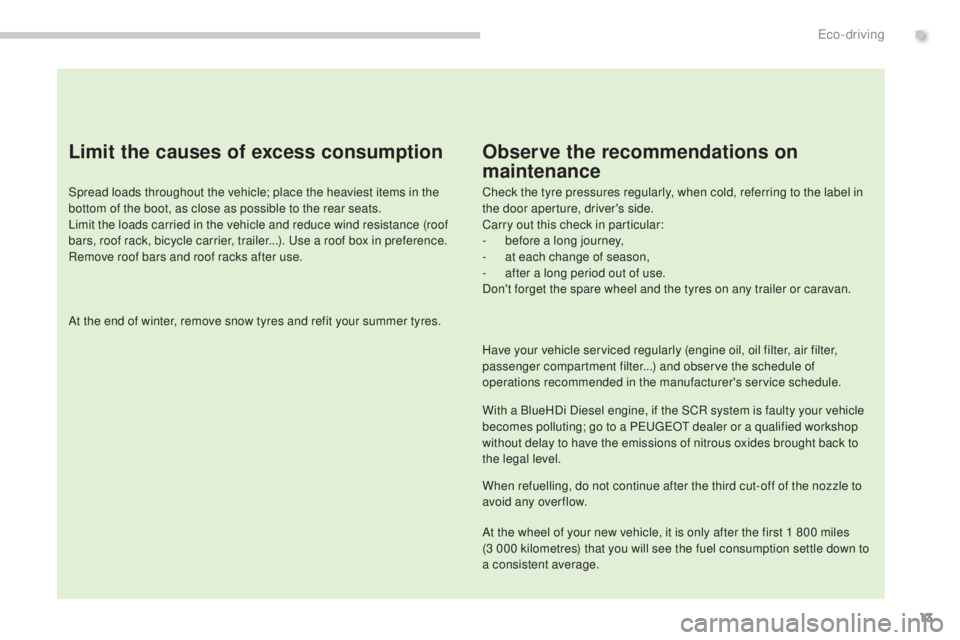
13
3008_en_Chap00c_eco-conduite_ed01-2015
Limit the causes of excess consumption
Spread loads throughout the vehicle; place the heaviest items in the
bottom of the boot, as close as possible to the rear seats.
Limit the loads carried in the vehicle and reduce wind resistance (roof
bars, roof rack, bicycle carrier, trailer...). Use a roof box in preference.
Remove roof bars and roof racks after use.
At the end of winter, remove snow tyres and refit your summer tyres.
Observe the recommendations on
maintenance
Check the tyre pressures regularly, when cold, referring to the label in
the door aperture, driver's side.
Carry out this check in particular:
-
b
efore a long journey,
-
a
t each change of season,
-
a
fter a long period out of use.
Don't forget the spare wheel and the tyres on any trailer or caravan.
Have your vehicle serviced regularly (engine oil, oil filter, air filter,
passenger compartment filter...) and observe the schedule of
operations recommended in the manufacturer's service schedule.
With a BlueHDi Diesel engine, if the SCR system is faulty your vehicle
becomes polluting; go to a PEUGEOT dealer or a qualified workshop
without delay to have the emissions of nitrous oxides brought back to
the legal level.
When refuelling, do not continue after the third cut-off of the nozzle to
avoid any over flow.
At the wheel of your new vehicle, it is only after the first 1 800 miles
(3
000 kilometres) that you will see the fuel consumption settle down to
a consistent average.
.
Eco-driving
Page 103 of 344
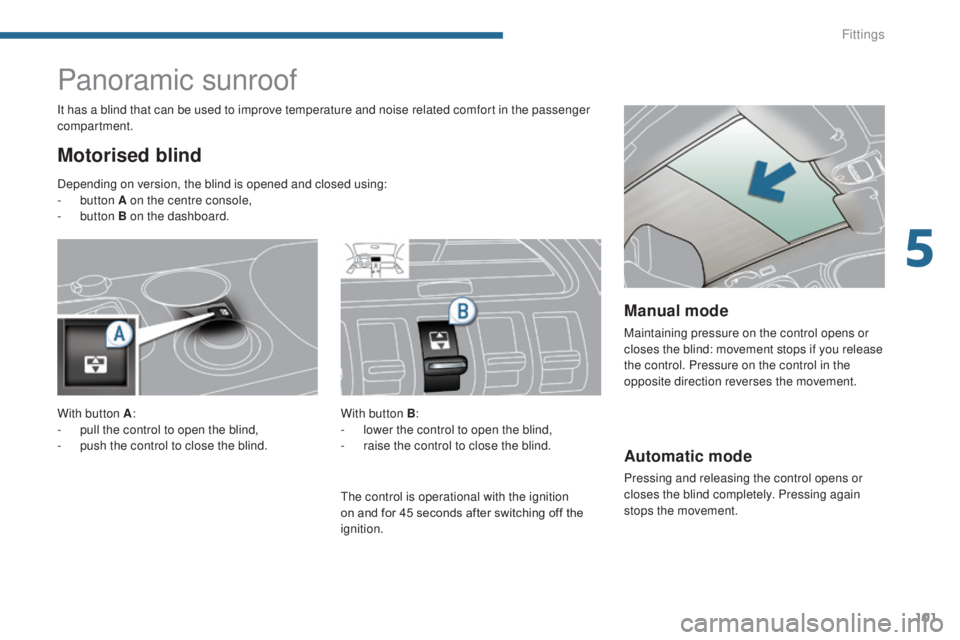
101
3008_en_Chap05_amenagements_ed01-2015
Automatic mode
Pressing and releasing the control opens or
closes the blind completely. Pressing again
stops the movement.
Panoramic sunroof
Motorised blind
It has a blind that can be used to improve temperature and noise related comfort in the passenger
compartment.With button B:
-
l
ower the control to open the blind,
-
r
aise the control to close the blind.
Manual mode
Maintaining pressure on the control opens or
closes the blind: movement stops if you release
the control. Pressure on the control in the
opposite direction reverses the movement.
Depending on version, the blind is opened and closed using:
-
button
A on the centre console,
-
button
B on the dashboard.
With button A :
-
p
ull the control to open the blind,
-
p
ush the control to close the blind. The control is operational with the ignition
on and for 45 seconds after switching off the
ignition.
5
Fittings
Page 137 of 344
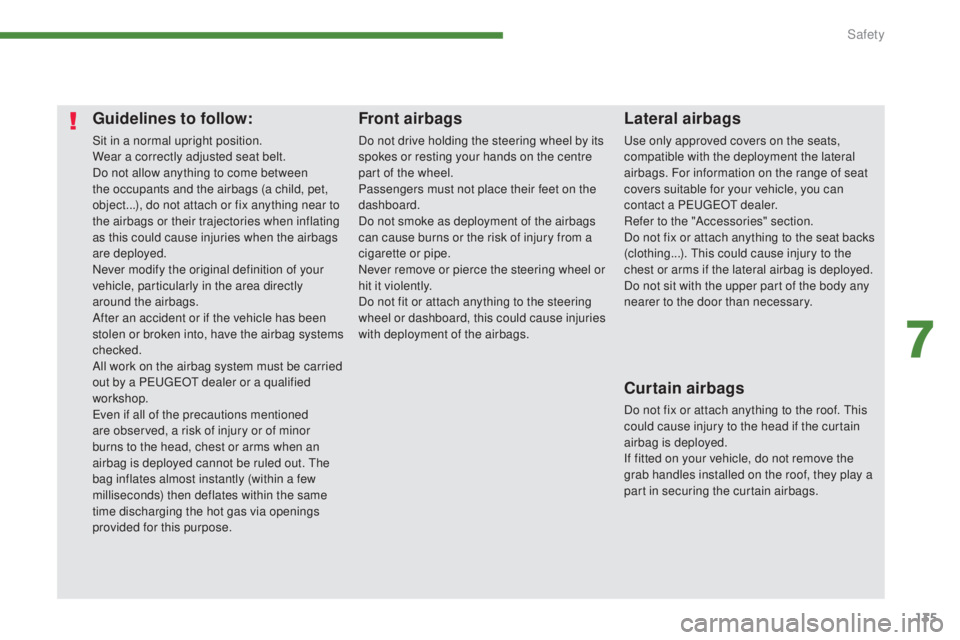
135
3008_en_Chap07_securite_ed01-2015
Guidelines to follow:
Sit in a normal upright position.
Wear a correctly adjusted seat belt.
Do not allow anything to come between
the occupants and the airbags (a child, pet,
object...), do not attach or fix anything near to
the airbags or their trajectories when inflating
as this could cause injuries when the airbags
are deployed.
Never modify the original definition of your
vehicle, particularly in the area directly
around the airbags.
After an accident or if the vehicle has been
stolen or broken into, have the airbag systems
checked.
All work on the airbag system must be carried
out by a PEUGEOT dealer or a qualified
workshop.
Even if all of the precautions mentioned
are observed, a risk of injury or of minor
burns to the head, chest or arms when an
airbag is deployed cannot be ruled out. The
bag inflates almost instantly (within a few
milliseconds) then deflates within the same
time discharging the hot gas via openings
provided for this purpose.
Lateral airbags
Use only approved covers on the seats,
compatible with the deployment the lateral
airbags. For information on the range of seat
covers suitable for your vehicle, you can
contact a PEUGEOT dealer.
Refer to the "Accessories" section.
Do not fix or attach anything to the seat backs
(clothing...). This could cause injury to the
chest or arms if the lateral airbag is deployed.
Do not sit with the upper part of the body any
nearer to the door than necessary.
Front airbags
Do not drive holding the steering wheel by its
spokes or resting your hands on the centre
part of the wheel.
Passengers must not place their feet on the
dashboard.
Do not smoke as deployment of the airbags
can cause burns or the risk of injury from a
cigarette or pipe.
Never remove or pierce the steering wheel or
hit it violently.
Do not fit or attach anything to the steering
wheel or dashboard, this could cause injuries
with deployment of the airbags.
Curtain airbags
Do not fix or attach anything to the roof. This
could cause injury to the head if the curtain
airbag is deployed.
If fitted on your vehicle, do not remove the
grab handles installed on the roof, they play a
part in securing the curtain airbags.
7
Safety
Page 226 of 344
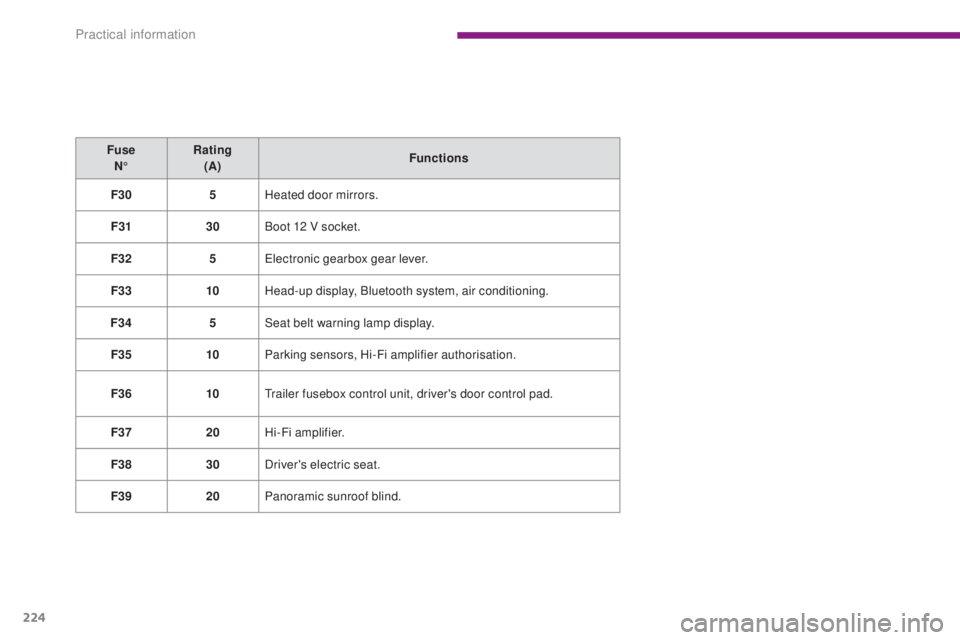
224
3008_en_Chap10_infos-pratiques_ed01-2015
Fuse N° Rating
(A) Functions
F30 5Heated door mirrors.
F31 30Boot 12 V socket.
F32 5Electronic gearbox gear lever.
F33 10Head-up display, Bluetooth system, air conditioning.
F34 5Seat belt warning lamp display.
F35 10Parking sensors, Hi-Fi amplifier authorisation.
F36 10Trailer fusebox control unit, driver's door control pad.
F37 20Hi-Fi amplifier.
F38 30Driver's electric seat.
F39 20Panoramic sunroof blind.
Practical information
Page 240 of 344
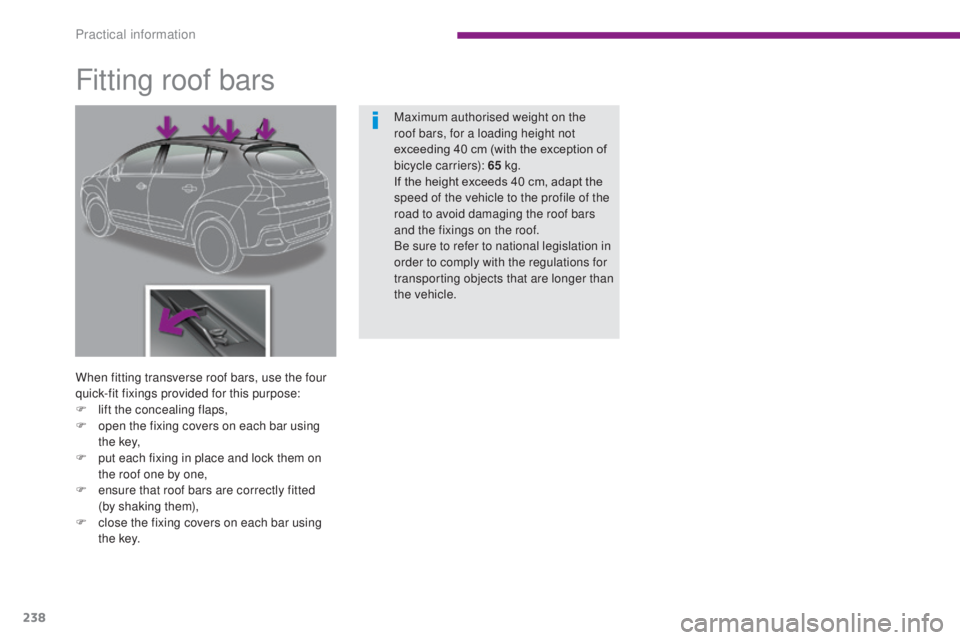
238
3008_en_Chap10_infos-pratiques_ed01-2015
Fitting roof bars
When fitting transverse roof bars, use the four
quick-fit fixings provided for this purpose:
F
l
ift the concealing flaps,
F
o
pen the fixing covers on each bar using
t h e key,
F
p
ut each fixing in place and lock them on
the roof one by one,
F
e
nsure that roof bars are correctly fitted
(by
shaking them),
F
c
lose the fixing covers on each bar using
t h e key. Maximum authorised weight on the
roof bars, for a loading height not
exceeding
40 cm (with the exception of
bicycle carriers): 65 kg.
If the height exceeds 40 cm, adapt the
speed of the vehicle to the profile of the
road to avoid damaging the roof bars
and the fixings on the roof.
Be sure to refer to national legislation in
order to comply with the regulations for
transporting objects that are longer than
the vehicle.
Practical information